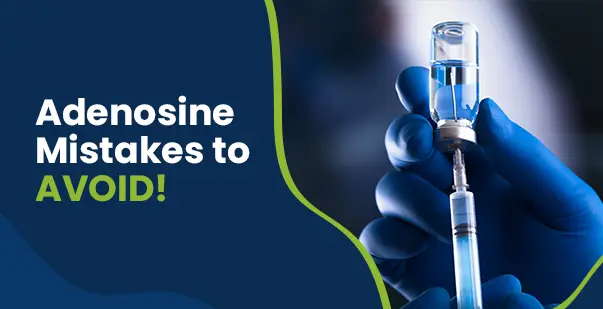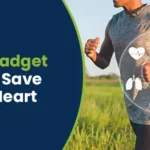Supraventricular tachycardia (SVT) causes the heart to beat very fast, which can make someone feel dizzy, short of breath, or even faint. In emergency care, one of the most trusted medicines to treat this condition is adenosine. It’s quick, effective, and often life-saving.
According to a study published in Elsevier Clinical Medicine, supraventricular tachycardia (SVT) affects approximately 2.25 per 1,000 individuals in the United States. Adenosine is a fast-acting medication used in Advanced Cardiovascular Life Support (ACLS) to help slow the heart rate during certain abnormal heart rhythms. It works by briefly stopping the heart’s electrical signals, allowing it to reset into a normal rhythm. When used correctly during ACLS, adenosine can safely and quickly bring the heart back to a normal pace. So, keep reading to find out why Adenosine is important in ACLS, key considerations, and dosing guidelines.
Master ACLS Now
Get ACLS certified with confidence
What is Adenosine in ACLS?
Adenosine belongs to a group of drugs known as antiarrhythmics. These medicines help correct abnormal heart rhythms, also called arrhythmias.
Adenosine works by briefly blocking the atrioventricular (AV) node, a component of the heart’s electrical system. The AV node helps pass electrical signals from the atria to the ventricles, the lower chambers of the heart. By slowing or stopping these signals for a moment, adenosine allows the heart to “pause” and then restart in a normal rhythm.
Adenosine is used in ACLS because it works quickly. Once administered through an intravenous (IV) line, it travels quickly to the heart and takes effect within seconds. Its action is also very short-lived as adenosine is broken down within less than 10 seconds in the body. This is why it’s often followed immediately by a saline flush to ensure the full dose reaches the heart quickly.
Now that we know how adenosine works in the body, let’s see when to administer adenosine in ACLS.
Read More: ACLS Certification in Arizona
When to Give Adenosine in ACLS?
In ACLS, adenosine is often used as a first-line treatment when a patient is stable but has a supraventricular tachycardia (SVT). “Stable” means the person is awake, has a pulse, and is breathing on their own, even though their heart rate is very fast.
Before giving adenosine, healthcare providers first try vagal maneuvers. According to the Cleveland Clinic, vagal maneuvers can slow down a supraventricular tachycardia (SVT) (fast heart rate) 20% to 40% of the time by stimulating the vagus nerve. Common vagal maneuvers include the Valsalva maneuver, which involves asking the patient to bear down as if having a bowel movement or having them cough hard. If these maneuvers don’t work, then adenosine is used to help “reset” the heart rhythm.
Note: Adenosine should not be used for other fast rhythms like atrial fibrillation (AFib), atrial flutter, or ventricular tachycardia (VT). These are different types of arrhythmias that need other treatments. That’s why it’s important to check if the person has a regular, narrow-complex tachycardia, as that is the correct condition for using adenosine. In this condition, the heart beats very fast, but the rhythm is even, and the electrical signals pass through the heart’s normal pathway.
Read More: SVT with Aberrancy or Ventricular Tachycardia
What is The Correct Adenosine Dosing in ACLS?
In ACLS, understanding the correct adenosine dose is crucial for treating certain types of supraventricular tachycardia (SVT). Too low may not work, and too high can increase the risk of side effects. Adenosine works quickly to slow the heart rate and restore normal rhythm. The table below outlines the recommended adenosine dosing in ACLS.
| Step | Dose | How to Give | Notes |
| First dose | 6 mg | Peripheral IV push quickly | Follow this with a 20 mL saline flush immediately. |
| Second dose | 12 mg | IV push quickly | Give if there is no response to the first dose. Follow with a saline flush. |
| Third dose | 12 mg | IV push quickly | It is optional. Do not exceed 3 total doses. |
Adenosine Administration Guidelines
Adenosine can restore a normal heart rhythm in over 86% of cases of certain types of fast heartbeats. It works super fast if it’s given the right way. Therefore, it is crucial to follow each step carefully when administering adenosine. The important guidelines to follow while administering adenosine are:
-
Use a Rapid IV Push
Adenosine needs to be given quickly through an IV bolus, so it can reach the heart before the body breaks it down. This rapid push is important because adenosine starts working within seconds, but it also leaves the body very quickly. If it’s given too slowly, it might not work well and may not stop the abnormal heart rhythm.
-
Follow the Dose with a Saline Flush
Right after giving adenosine, follow it with a normal saline flush, usually about 20 mL. The saline helps push the medication all the way into the bloodstream and toward the heart. Without this flush, adenosine may stay in the IV line and not reach the heart fast enough. This step ensures the drug works correctly and on time.
-
Use a Stopcock or Two-Syringe Method
The best way to administer adenosine is using a stopcock system or the two-syringe method. A stopcock is a small valve used in IV setups that allows quick switching between syringes. These methods allow the healthcare provider to push the medication and saline flush quickly, one right after the other. Timing is very important with adenosine. A delay of even a few seconds can make the drug less effective. This setup ensures a fast and smooth delivery of the medicine.
-
Place the IV Line Close to the Heart
To ensure adenosine reaches the heart quickly, place the IV line in a large vein near the heart. The antecubital vein, which is inside the elbow, is a good choice. Avoid placing the IV in small or distant veins, like those in the hand. The closer the IV is to the heart, the faster the medicine will work.
-
Monitor the Patient Closely
Watch the patient’s heart rhythm during and after giving adenosine for at least 1-2 minutes. You may see a brief pause in the heart’s electrical activity. This is called transient asystole. On the ECG, it may appear as a flat line for 1–3 seconds. Don’t panic, this is expected, and the heart usually starts beating normally again right after. Keep the patient on a cardiac monitor and stay alert for any sudden changes.
- Have Emergency Equipment Ready
Although adenosine is usually safe, it can sometimes cause serious side effects like chest pain or breathing problems. Always keep emergency equipment nearby. This includes a crash cart, oxygen, and tools to support breathing or blood pressure if needed. Being ready ensures that you can act fast if the patient has an adverse reaction to the medicine.
When NOT to Use Adenosine?
Adenosine is effective in ACLS, but it’s not suitable for all patients. A study published in Cureus found that nearly one-third of patients who received adenosine experienced side effects that lasted for less than 60 seconds. That’s why it’s just as important to know when not to use adenosine as it is to know when to use it. The contraindications for adenosine administration are discussed as follows:
- Second- or Third-Degree Heart Block: These are serious problems in the heart’s electrical system. If the person does not have a working pacemaker, adenosine can stop the heart’s signals completely and cause the heart to slow down too much or even stop for a few seconds.
- Sick Sinus Syndrome: This is a condition where the heart’s natural pacemaker (the sinus node) does not work properly. Adenosine may make this worse and cause dangerous, slow heart rhythms.
- Asthma or severe breathing problems: Adenosine can constrict the airways in the lungs. This can trigger wheezing, shortness of breath, or even a serious asthma attack. People with asthma or chronic obstructive pulmonary disease (COPD) should not receive adenosine.
- Atrial Fibrillation (AFib) or Atrial Flutter: Adenosine is not helpful for these irregular heart rhythms. In fact, in some cases, it might worsen the heart rhythm or cause a very fast heartbeat in the lower chambers (ventricles).
- Allergy to Adenosine: Although rare, anyone with a known allergy to adenosine should not be given the drug.
What Are The Side Effects of Adenosine?
Most side effects of adenosine are short-lived and go away within a minute, but patients should still be closely monitored after administration. Some of the common side effects of adenosine dosing include the following:
- Chest pain or tightness
- Shortness of breath or breathing discomfort
- Flushing (a sudden warm, red feeling, especially in the face)
- Dizziness or lightheadedness
- A strange feeling of fear or anxiety
- A brief pause in heart activity (called asystole)
Read More: ACLS And Adenosine
Use Adenosine in ACLS Safely and Effectively!
Adenosine in ACLS is a fast-acting drug used to treat stable SVT. It works by briefly blocking the heart’s electrical signals to help reset the rhythm. When used correctly with the right dose, a fast IV push, and proper monitoring, it can safely return the heart to normal. But it’s not for every fast heart rhythm. Hence, knowing when not to use adenosine is just as important as knowing when to give it.
If you’re a healthcare provider, understanding how to use adenosine can save lives in emergencies. Want to learn more? Sign up for an online ACLS training course today and build the confidence to act fast and smart during cardiac emergencies!







